Spiritual Altar Meaning
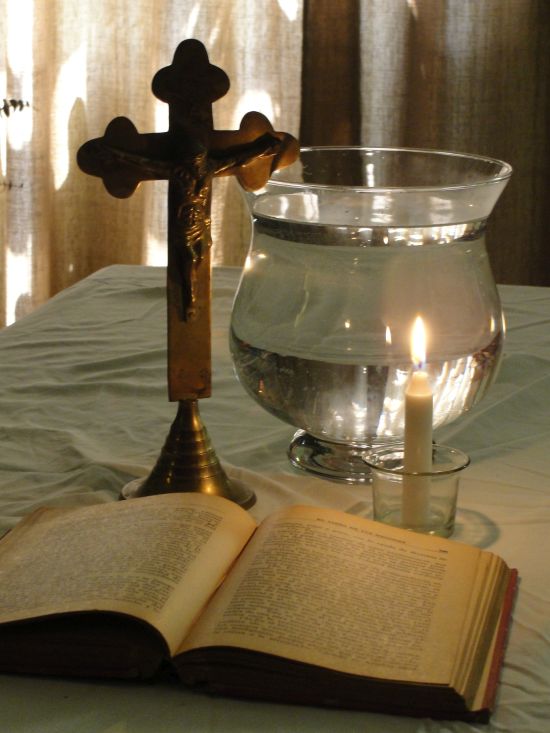
Spiritual Altar Meaning
A Sacred Space To Connect With God and His/Her Spirit Messengers
What is a Spiritual Altar?
Throughout history, man has had a need to establish a connection with God and the spiritual realm. In his quest to satisfy this inner need, the concept of an altar was created.
A spiritual altar is a sacred space where individuals can connect with a higher power, seek guidance, and offer prayers, intentions, and gratitude. It serves as a focal point for spiritual growth, reflection, and worship, allowing individuals to cultivate a deeper sense of spirituality and connection with the Divine. Whether it’s a small table or an end table adorned with candles and incense or a more elaborate setup with statues and sacred texts, the essence of a spiritual altar lies in its ability to provide a sanctuary for the soul. This personal space becomes a haven where one can retreat from the chaos of daily life and find solace in the presence of the Divine.
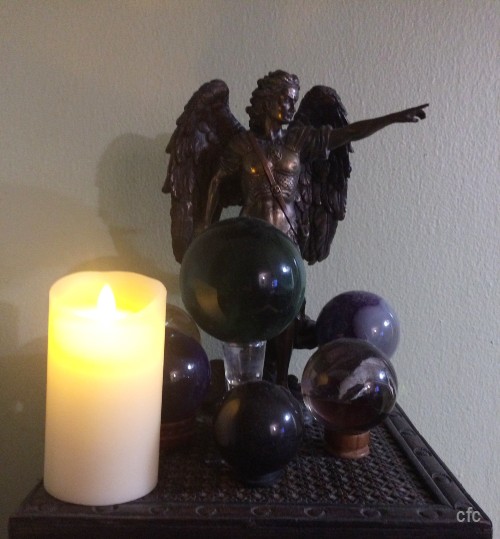
Spiritual Altar Meaning
The spiritual altar represents a symbolic threshold between the physical and spiritual realms, where individuals can transcend their mundane concerns and connect with the sacred. It embodies the idea of sacrifice, surrender, and devotion, inviting individuals to let go of their egos and limitations and to open themselves to the Divine. Just as the ancient Israelites offered burnt offerings on the brazen altar in the temple courtyard, modern spiritual practitioners use their altars to present their own gifts sacred to the Divine. This act of creating and maintaining an altar is the ultimate way to honor and commune with the Higher Power that guides and sustains us.
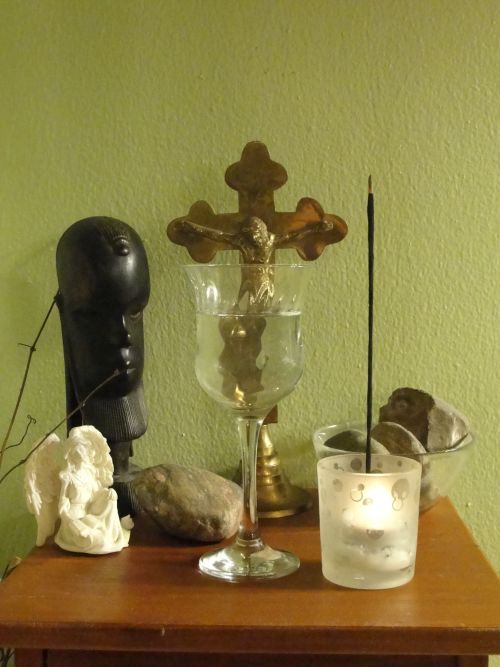
Types of Spiritual Altars
There are various types of spiritual altars, each with its unique characteristics and purposes. Some common types include:
- Meditation Altar: A quiet space for contemplation, reflection, and mindfulness practices. This type of altar often includes items that promote peace and tranquility, such as candles, incense, and stones.
- Prayer Altar: A sacred space for offering prayers, intentions, and gratitude to a Higher Power. It may feature religious icons, sacred texts, and other items that hold spiritual significance.
- Ritual Altar: A space for performing sacred rituals, ceremonies, and sacraments. This altar is often more elaborate, with specific tools and elements needed for various spiritual practices.
- Ancestor Altar: A space for honoring and connecting with ancestors and loved ones who have passed on. This type of altar typically includes photos, mementos, and offerings that pay tribute to those who have gone before us.
Each type of altar serves a distinct purpose, yet all share the common goal of fostering a deeper connection with the Divine and the spiritual world.
The Function of a Spiritual Altar
The primary function of a spiritual altar is to facilitate a deeper connection with the Divine, oneself, and others. It serves as a:
- Sacred Space for Worship, Prayer, and Meditation: A place where individuals can focus their spiritual energy and engage in practices that nurture their souls.
- Symbolic Threshold Between the Physical and Spiritual Realms: An altar acts as a bridge, allowing individuals to transcend their everyday concerns and connect with the sacred.
- Focal Point for Spiritual Growth, Reflection, and Transformation: By regularly engaging with their altar, individuals can cultivate a deeper sense of spirituality and personal growth.
- Space for Offering Gratitude, Intentions, and Prayers: An altar provides a dedicated space for expressing thanks, setting intentions, and seeking guidance from the divine.
- Reminder of the Sacred and the Divine: The presence of an altar in one’s home serves as a constant reminder of the spiritual aspects of life and the importance of maintaining a connection with the divine.
Design and Elements of a Spiritual Altar
A spiritual altar can be designed and created with various elements, including:
- Sacred Objects: Statues, icons, or relics that hold spiritual significance. These items serve as focal points for worship and reflection.
- Candles, Incense, and Other Sensory Elements: These elements help create a sacred atmosphere and can enhance the spiritual experience. The use of incense on an incense altar, for example, can symbolize the prayers rising to the heavens.
- Natural Elements: Plants, stones, or water that represent the natural world and its connection to the divine. These elements can ground the altar and bring a sense of harmony.
- Symbolic Objects: Crosses, mandalas, prayer beads or other sacred symbols that hold personal or religious significance. These items can serve as reminders of one’s faith and spiritual journey.
- Personal Items: Photos, mementos, or heirlooms that hold personal meaning. Including these items can make the altar more personal and reflective of one’s unique spiritual path. This can also include tarot or oracle cards.
- Sacred Texts: Scriptures, prayers, or poetry that inspire and guide one’s spiritual practice. These texts can provide wisdom and insight during times of reflection and meditation.
The design and elements of a spiritual altar should reflect the individual’s personal beliefs, values, and spiritual practices, and should be created with intention, reverence, and respect. Whether it’s a simple set up with a few meaningful items or a more elaborate arrangement, the key is to create a space that resonates with your spirit and supports your spiritual journey.
My Personal Experience
I grew up in a spiritual community where altars were a common sight. I remember visiting my mother's friends and family and seeing altars of various sizes. They all served the same purpose - to connect with the spirit world.
When I reached a certain age, I created my own spiritual altar. It was simply a replica of what I had seen before. As I began to develop spiritually and connect with my spirit guides, a new way of looking at things began to unfold. With the assistance of a spirit guide, I was able to delve deeper into the true meaning of a spiritual altar.
Spirits explained that an altar was very personal and should reflect the essence of the person’s spiritual development, with God being the center of all.
My altar is my go to whenever I am facing a situation that is out of my control. It is also the place where I pray for others who are in need of spiritual help. Whenever I am at my altar, I feel the presence and positive energy of my spirit guides around me.
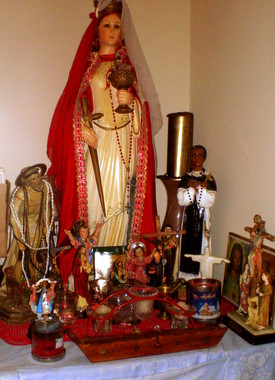 Espiritismo Altar
Espiritismo AltarWhen placing an item on an altar, one should know its purpose. Additionally, it is essential to be aware of the energy surrounding the altar.
Some items, such as crystals, create a heightened level of energy. Certain spirits recommend having one or two crystals on the altar. However, not all altars need crystals. It all depends on what the person's guides feel is necessary.
One woman told me that, among other things, she kept a rose quartz and clear quartz on her altar for spiritual love and strength.
Some people have statues of saints on their altars. They faithfully pray to these saints and are grateful for requests that were granted to them.
It is important to know that no saint or spirit can grant requests without the permission of God. That is why a symbol representing God should be placed in the center of the altar.
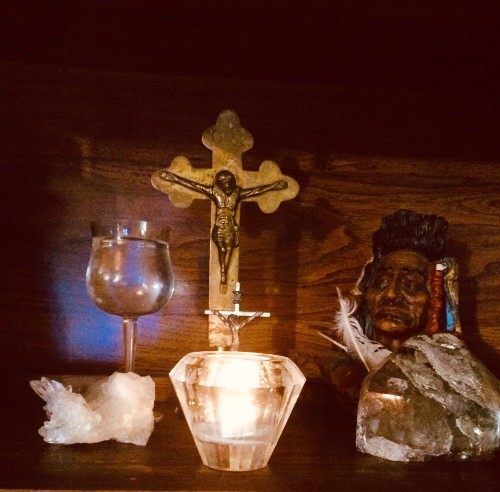 Christ and Indian Spirit Guide
Christ and Indian Spirit Guide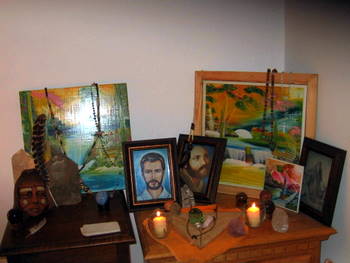
When I asked one of the individuals, who submitted a picture of her altar, about the purpose of her altar, she revealed the following:
“My altar is composed of saints who have great meaning to me. They are saints whom I prayed to when I was experiencing problems. Moreover, it is the place I go to whenever I require strength. There, I can relax and see things clearly.”
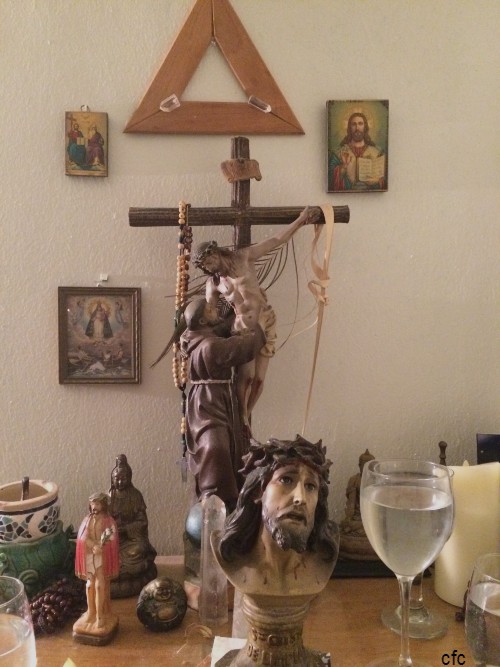
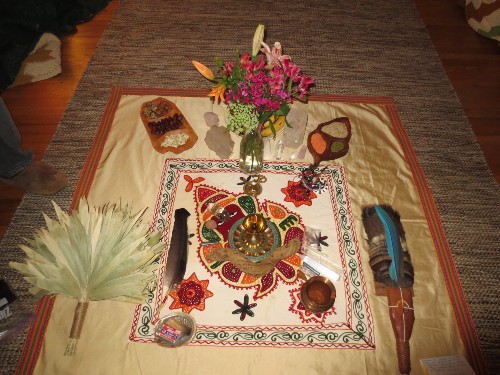 Ayahuasca Ceremonial Altar
Ayahuasca Ceremonial Altar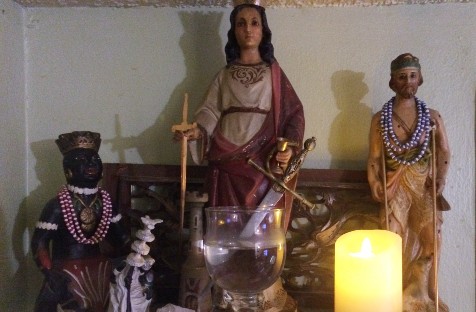 Chango, Saint Barbara and San Lazaro
Chango, Saint Barbara and San LazaroIn Santeria, an altar is called boveda. A boveda is usually a small table with a white tablecloth over it. Seven or nine goblets of water are placed on top. The largest one is in the middle and dedicated to the person's main spirit guide.
In the book Santeria- The Religion, Megene Gonzalez-Wippler writes that practitioners of Santeria, "believe that whenever a goblet fills with air bubbles, it is an indication that there are spiritual entities- often of a negative nature- in the vicinity. The water therefore acts as a kind of spiritual cleansing and as a subtle 'trap' for impure spirits."
In Jambalaya by Luisah Teish, she gives a guideline for building a small altar. A piece of white cloth, a crystal chalice filled with water with a tablespoon of anisette, white rum, or white wine (this water is called spirit water), a white candle, four stones, and pictures of ancestors are items needed to create an altar.
In the Umbanda religion, an altar consists of the following essential elements: fire, earth, water, and air. During a recent Umbanda ceremony, the person in charge explained the various items on the temple's altar. There were three candles representing the fire element, each dedicated to specific orishas. I remember one was for Oshun, the Goddess of Rivers and Love. In front of the candles was a glass of water, representing the water element, which is believed to clear and take in all negative energy. A rock was located in front of the glass of water, symbolizing the earth element. Since orishas are earth spirits, having an item representing the earth is considered essential. The air element is self-explanatory.
Additional items were placed on this specific altar, including a small statue representing the temple's main spirit guide, flowers, and a solid white substance resembling chalk called cascarilla. Cascarilla is made from powdered eggshells. Mediums channeling spirits used cascarilla to inscribe their names on the ground. In certain spiritual traditions, cascarilla is utilized in various spiritual rituals.
Whatever kind of altar you have or are in the process of creating, it is important to remember that LOVE is the main ingredient.
Remember to cleanse your altar regularly using holy water, Florida water, sage, palo santo, essential oil sprays, or whatever is best for you.
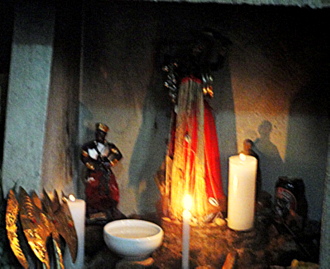 Umbanda Altar
Umbanda Altar

Spiritual Messages and Paintings and Spiritual Tales books are now available on Amazon.

Click on the fine art america logo below to view more than 600 pieces of spiritual artwork

Spiritual altar meaning, spiritual altar meaning
Recent Articles
-
How to do Automatic Writing -Psychographic Spirit Writing
Oct 05, 24 08:26 PM
How to do Automatic Writing is a spiritual practice connecting individuals with higher realms to produce writing messages from the spirit realm -
Brujeria Black Magic
Oct 05, 24 12:11 AM
Brujeria Black Magic Spells: Some people blame mishaps on black magic, believing they have been hexed. Is it real or a Paranoid Disorder? Let's explore. -
Spiritual Warfare-Battle Between Good and Evil
Oct 03, 24 12:05 AM
Spiritual warfare has been ongoing for some time, and now, the final confrontation between Michael and Lucifer has arrived. Come and discover the outcome.



